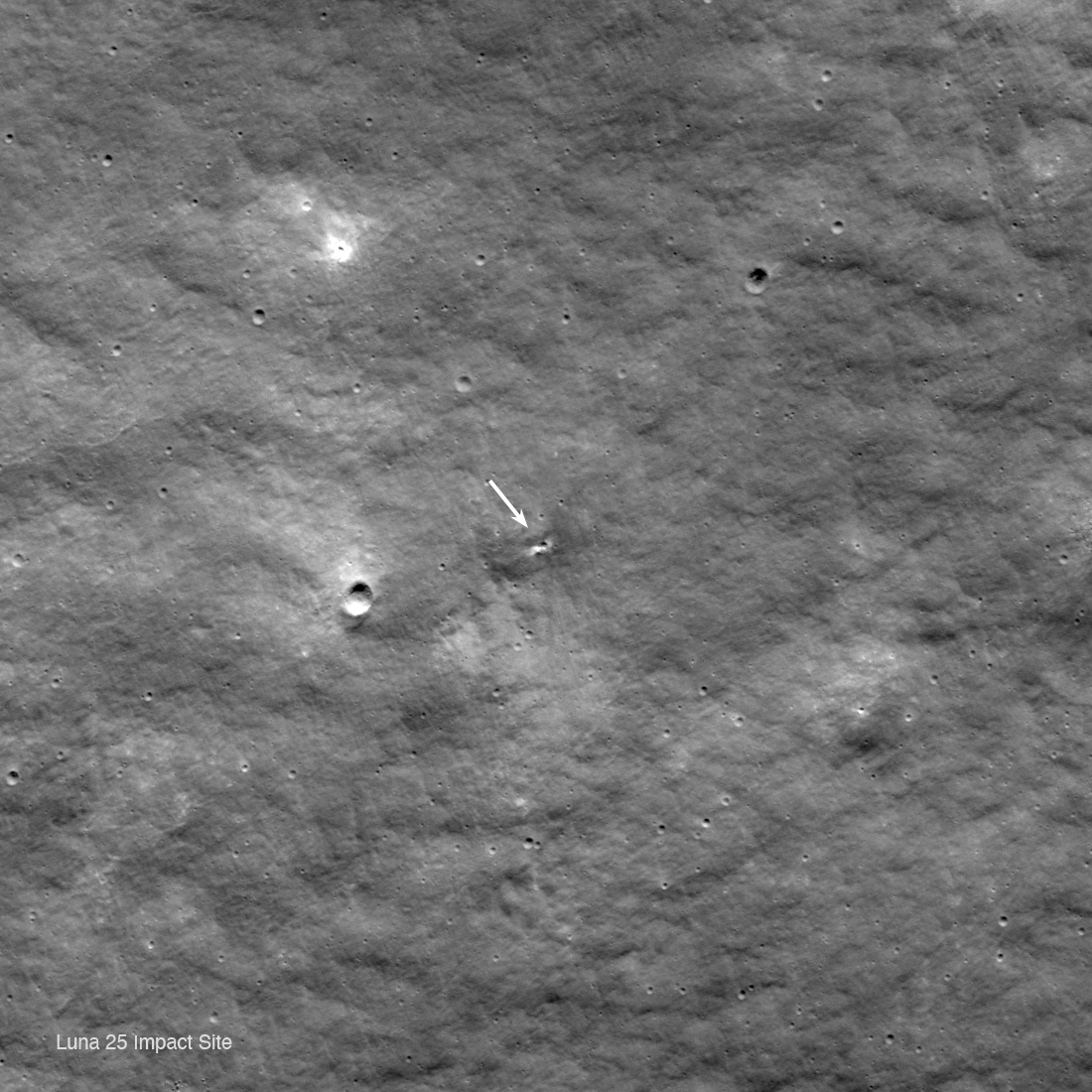Poor Russia. They can’t seem to get much right. Their most recent failure is their Luna 25 spacecraft. It was supposed to land near the Moon’s south pole but instead crashed into the surface on August 19th.
Now NASA’s Lunar Reconnaissance Orbiter (LRO) has spotted Luna 25’s final resting place.
Luna 25 was Russia’s first mission to the Moon in over 40 years. Roscosmos launched it into orbit on August 10th on a Soyuz 2.1b rocket from the Vostochny Cosmodrome. The launch and the travel to the Moon went well, and the spacecraft entered lunar orbit on August 16th. But, perhaps sadly, it crashed while executing a failed orbital maneuver.

Initially, Roscosmos announced that they’d lost contact with the spacecraft. “The measures taken on August 19 and 20 to search for the device and get into contact with it did not yield any results,” Roscosmos reported.
Later, on Telegram, they said, “During the operation, an emergency situation occurred on board the automatic station, which did not allow the maneuver to be performed with the specified parameters.”
Luna 25 was in a sort of race with India’s Chandrayaan-3 lunar lander. C3 was launched before L25, but Roscosmos planned for L25 to pass the Indian lander and reach the Moon’s surface first. It did reach the surface first, but only as a wreck. And as everybody knows, C3 landed successfully and is going about its business. That must sting.

On August 21, Roscosmos revealed the likely location of L25’s impact, and NASA instructed the LRO to image the region. On August 24, the LRO captured these images and compared them to previous images of the same region pre-impact. The most recent pre-impact image is from June 2022, and a small new crater appeared sometime between the dates of the two images. The new crater is so close to the impact site that NASA confidently concluded that the new crater is indeed the impact crater created by L25’s crash. The crater is about 10 meters (33 feet) in diameter.

Russia is a political pariah right now for obvious reasons. But Luna 25 was predominantly a scientific endeavour, so it’s unfortunate that the mission failed.
Luna 25 carried eight science instruments, including an instrument for the spectrometry of minerals, an important part of modern lunar exploration. It was also going to measure the regolith’s thermal properties, measure plasma in the exosphere, and measure dust and micrometeorites, among other things. But that’s all gone now.
Luna 25 was also going to carry a demonstration navigation camera provided by the ESA, but they pulled it after Russia invaded Ukraine. The ESA announced that they were discontinuing their participation in Luna 25, 26 and 27, saying, “As with ExoMars, the Russian aggression against Ukraine and the resulting sanctions put in place represent a fundamental change of circumstances and make it impossible for ESA to implement the planned lunar cooperation.”
There’s significant schadenfreude involved in Russia’s failures right now, and that’s not likely to dissipate any time soon. That’s what happens when you invade your neighbour and do all the terrible things Russia’s done. It’s just the way it is.
But Russia is a dictatorship, and while leadership might deserve to fail, this latest disappointment must be difficult for the dedicated scientists and other personnel who have no way of voicing discontent and do their work while suffering under crude leadership. There must be some people in Russia like that, right?
Luna 25’s failure might not be restricted to this single mission. It was intended as a sort of test bed for subsequent landers in the Luna series. Will this failure affect future Luna missions?
Russia is not exactly open about its failures. For example, when their Phobos-Grunt mission to Mars’ largest moon failed, they quickly blamed foreign sabotage. So far, they haven’t placed blame for Luna 25’s crash on anyone, but they still might.

The real problem might lie with the nature of Russian society. Rampant corruption is well-documented in Russia, and corruption tends to eat into everything. It may have played a role in Luna 25’s failure, but that’s only speculation at this point. We may never know exactly what role it might have played.
For its part, NASA has avoided criticizing or condemning Russia’s latest failure. Thomas Zurbuchen, NASA’s former Associate Administrator for the Science Mission Directorate, had a conciliatory message for Roscosmos. He said on X, “Too bad to read this. None of us ever wishes bad onto other explorers. Hope this can be fixed. We are reminded that landing on any celestial object is anything but easy & straightforward. Just because others managed to do it decades ago does not guarantee success today.”
Classy, diplomatic words.
This latest Russian failure is just another chapter in their decline. If there’s a new space race happening between nations, Russia isn’t really participating.
Prior to Luna 25’s launch, NASA Administrator Bill Nelson wished Russia well, emphasizing the cooperation between NASA and Roscosmos over the decades, pointing out that the two built the ISS together. But he also said, “I don’t think a lot of people at this point would say that Russia is actually ready to be landing cosmonauts on the Moon in the timeframe that we’re talking about going to the Moon or that China would be,” he said.

